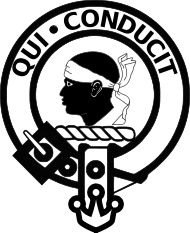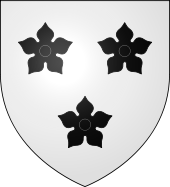- Clan Borthwick
-
Clan Borthwick Crest badge 
Crest: A moor's head couped Proper wreathed Argent and Sable Motto: Qui conducit ("He Who Leads") Profile Chief

John Hugh Borthwick of that Ilk 24th Lord Borthwick Clan Borthwick is a Scottish clan.
Contents
History
Origins of the Clan
The origins of the name "Borthwick" are territorial. The name seems likely to have been assumed from Borthwick Water in Roxburghshire.[citation needed]
It is traditionally held that the first of the noble house was Andreas, who accompanied the Saxon Edgar Ætheling and his sister, Saint Margaret of Scotland, to Scotland in 1067.[citation needed]
15th century
Around 1410 Sir William Borthwick 'the elder' obtained a charter confirming his possession of the lands around Borthwick and it was during the 15th century that the family gained great wealth and influence, (it was probably his grandson) becoming Lords of the Parliament of Scotland.[citation needed]
The First Lord Borthwick (born c1412, dc 1458) was one of the child nobles sent to England as substitute hostages for the ransom of James I of Scotland in 1425. He was responsible for the construction of what is now one of the most impressive fortified dwellings in Scotland.[citation needed]
16th century
The Battle of Flodden Field
During the Anglo-Scottish Wars the Borthwicks fought on the side of King James IV of Scotland at the Battle of Flodden Field in 1513 and suffered badly in the defeat. William, 4th Lord Borthwick, whose father had died in the previous decade, succeeded to obtain important offices already at the approximate age of 20 in aftermath of the battle, because so many maturer noblemen had been slain in the battle – he was given command of Stirling Castle and charged with the safety of the infant James V of Scotland. The Complete Peerage informs that no Lord borthwick fell in the Flodden battle.[citation needed]
John, Lord Borthwick was an opponent of the Reformation of the Church of Scotland and a supporter of Mary of Guise. His adherence to the church, however, did not mean he was in favour with the church hierarchy and in 1547 he was excommunicated for contempt of the Ecclesiastical Court of the See of St Andrews. An officer of the court, William Langlands, was dispatched to deliver the letters of excommunication to the curate of Borthwick. Langlands was seized by Borthwick's men and thrown in the mill dam north of the castle. Later they made him eat the letters, having first soaked them in wine. He was sent back with the warning that any other letters would 'a gang the same gait'.[citation needed]
John's son, William, was a close friend and confidant of Mary, Queen of Scots. Mary took refuge with her husband, James Hepburn, 4th Earl of Bothwell, but was forced to flee when a force under James Stewart, Earl of Moray approached. She is said to have escaped dressed as a page[citation needed]
In 1573, David Borthwick of Lochhill became the king's advocate, and may have been the first to bear the title Lord Advocate, though not the position.[citation needed]
The Civil War
During the Wars of the Three Kingdoms and the English Civil War the Borthwicks sided with the Royalists and were besieged following the Battle of Dunbar (1650). Oliver Cromwell offered Lord Borthwick honourable terms for surrender, which he accepted, thereby saving the castle from almost certain destruction. Lord Borthwick was allowed to leave with his family and goods. Thereafter the direct line failed and the title became dormant.[citation needed]
18th century
In 1762 Henry Borthwick of Neathorn was recognised as male heir first Lord by the House of Lords. He assumed the title but died without heirs ten years later. During the 18th century and 19th century various branches of the family disputed the line of succession until in 1986, Major John Borthwick of Crookston was recognised by the Lord Lyon, King of Arms as Borthwick of that Ilk, chief of the name and arms of Borthwick. He also became the 23rd Lord Borthwick in the Peerage of Scotland. His son John Hugh Borthwick became the 24th Lord Borthwick three months prior to his death.[1][2]
Clan Castle
The seat of Clan Borthwick has always been at Borthwick Castle.[citation needed]
Clan Chief
John Hugh Borthwick of that Ilk, 24th Lord Borthwick, Chief of the Name and Arms of Borthwick, 18th of Crookston, Baron of Heriotmuir.[1]
See also
External links
References
- Lundy, Darryl. "John Henry Stuart Borthwick of that Ilk, 23rd Lord Borthwick". thePeerage.com. http://www.thepeerage.com/p2564.htm#i25631. Retrieved 7 December 2006.
- Lundy, Darryl. "John Hugh Borthwick of that Ilk, 24th Lord Borthwick". thePeerage.com. http://www.thepeerage.com/p13796.htm#i137956. Retrieved 7 December 2006.
Scottish clans Clans with chiefs Agnew · Anstruther · Arbuthnott · Arthur · Bannerman · Barclay · Borthwick · Boyd · Boyle · Brodie · Broun · Bruce · Buchan · Burnett · Cameron · Campbell · Carmichael · Carnegie · Cathcart · Charteris · Chattan · Chisholm · Cochrane · Colquhoun · Colville · Cranstoun · Crichton · Cumming · Darroch · Davidson · Dewar · Drummond · Dunbar · Dundas · Durie · Elliot · Elphinstone · Erskine · Farquharson · Fergusson · Forbes · Forsyth · Fraser · Fraser of Lovat · Gayre · Gordon · Graham · Grant · Gregor · Grierson · Guthrie · Haig · Haldane · Hamilton · Hannay · Hay · Henderson · Home · Hope · Hunter · Irvine · Jardine · Johnstone · Keith · Kennedy · Kerr · Kincaid · Lamont · Leask · Lennox · Leslie · Lindsay · Lockhart · Lumsden · Lyon · MacAlister · MacBain · MacDonald · Macdonald of Clanranald · MacDonald of Keppoch · Macdonald of Sleat · MacDonell of Glengarry · MacDougall · Macdowall · MacIntyre · Mackay · Mackenzie · Mackinnon · Mackintosh · Maclachlan · Maclaine of Lochbuie · MacLaren · MacLea (Livingstone) · Maclean · MacLennan · MacLeod · MacLeod of Lewis · MacMillan · Macnab · Macnaghten · MacNeacail · MacNeil · Macpherson · MacTavish · MacThomas · Maitland · Makgill · Malcolm (MacCallum) · Mar · Marjoribanks · Matheson · Menzies · Moffat · Moncreiffe · Montgomery · Morrison · Munro · Murray · Napier · Nesbitt · Nicolson · Ogilvy · Oliphant · Primrose · Ramsay · Rattray · Riddell · Robertson · Rollo · Rose · Ross · Ruthven · Sandilands · Scott · Scrymgeour · Sempill · Shaw · Sinclair · Skene · Spens · Stirling · Strange · Stuart of Bute · Sutherland · Swinton · Trotter · Urquhart · Wallace · Wedderburn · Wemyss · Wood ·
Armigerous clans Abercromby · Abernethy · Adair · Adam · Aikenhead · Ainslie · Aiton · Allardice · Anderson · Armstrong · Arnott · Auchinleck · Baillie · Baird · Balfour · Bannatyne · Baxter · Bell · Belshes · Bethune · Beveridge · Binning · Bissett · Blackadder · Blackstock · Blair · Blane · Blyth · Boswell · Brisbane · Buchanan · Butter · Byres · Cairns · Calder · Caldwell · Callender · Campbell of Breadalbane · Campbell of Cawdor · Carruthers · Cheyne · Chalmers · Clelland · Clephane · Cockburn · Congilton · Craig · Crawford · Crosbie · Cunningham · Dalmahoy · Dalrymple · Dalzell · Dennistoun · Don · Douglas · Duncan · Dunlop · Edmonstone · Fairlie · Falconer · Fenton · Fleming · Fletcher · Forrester · Fotheringham · Fullarton · Galbraith · Galloway · Gardyne · Gartshore · Ged · Gibsone · Gladstains · Glas · Glen · Glendinning · Gray · Gunn · Haliburton · Halkerston · Halket · Hepburn · Heron · Herries · Hogg · Hopkirk · Horsburgh · Houston · Hutton · Inglis · Innes · Kelly · Kinloch · Kinnaird · Kinnear · Kinninmont · Kirkcaldy · Kirkpatrick · Laing · Lammie · Langlands · Learmonth · Little · Logan · Logie · Lundin · Lyle · MacAulay · Macbrayne · MacDuff · MacEwen · MacFarlane · Macfie · Macgillivray · MacInnes · MacIver · Mackie · MacLellan · Macquarrie · Macqueen · Macrae · Masterton · Maule · Maxton · Maxwell · McCorquodale · McCulloch · McKerrell · Meldrum · Melville · Mercer · Middleton · Moncur · Monteith · Monypenny · Mouat · Moubray · Mow · Muir · Murray of Atholl · Nairn · Nevoy · Newlands · Newton · Norvel · Ochterlony · Orrock · Paisley · Paterson · Pennycook · Pentland · Peter · Pitblado · Pitcairn · Pollock · Polwarth · Porterfield · Preston · Pringle · Purves · Rait · Ralston · Renton · Roberton · Rossie · Russell · Rutherford · Schaw · Seton · Skirving · Somerville · Spalding · Spottiswood · Stewart · Stewart of Appin · Strachan · Straiton · Strange · Sydserf · Symmers · Tailyour · Tait · Tennant · Troup · Turnbull · Tweedie · Udny · Vans · Walkinshaw · Wardlaw · Watson · Wauchope · Weir · Whitefoord · Whitelaw · Wishart · Young
Culture and society Scotland · Clan chief · Septs · Clan badge · Clan crest · Clan battles · Tartan · Bagpipes · Clearances · Kilt · Manrent · The Highlands · Battle of Culloden · Highland games · Border Reivers · Scottish heraldry · Scottish surnames
Categories:- Scottish clans
Wikimedia Foundation. 2010.

